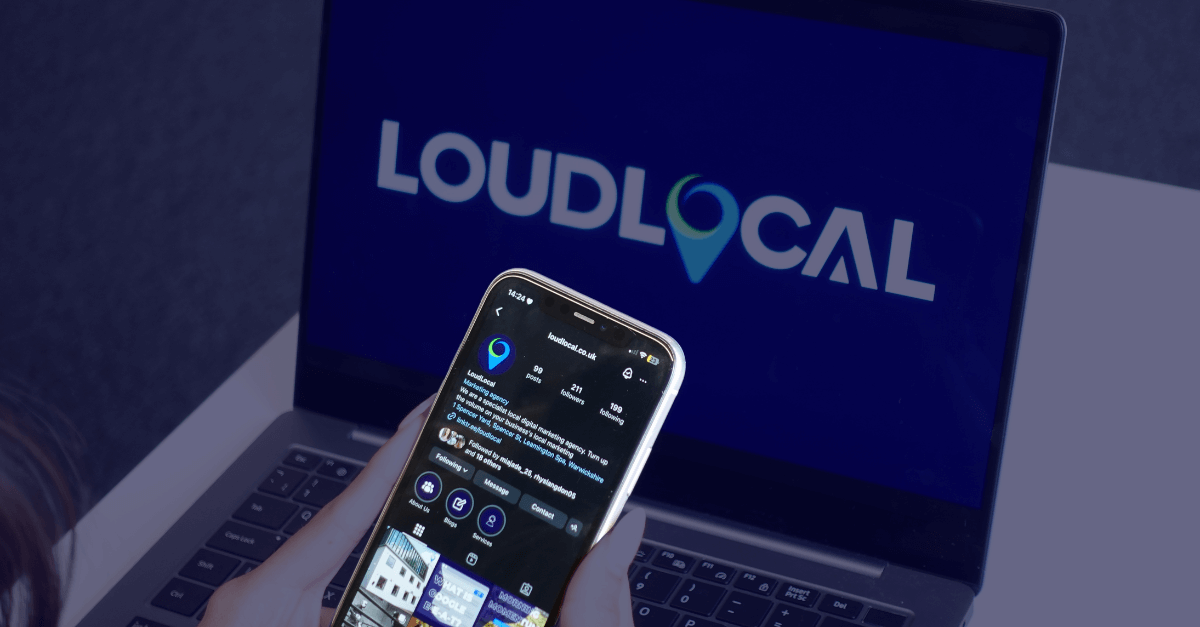How Often Should You Post on Social Media: A Small Business Guide
Running a small business is a full-time job in itself, and finding time for social media can feel like an extra task on the list. But here’s the...
Got a question, or need help with something?
A member of the LoudLocal team is on hand to help you.
The Brickyard, Unit 2, Queen's Rd, Kenilworth, Warwickshire, CV8 1JQ
5 Merchant Square, Paddington, London, W2 1AY
11 min read
Taya Grao-Randall
:
Nov 12, 2025 4:05:49 PM
Running a small business is a full-time job in itself, and finding time for social media can feel like an extra task on the list. But here’s the thing: the way you show up online makes a real difference. Post too little and people forget about you. Post too much and you risk annoying the very customers you’re trying to win over.
So, how often should small businesses post on social media? That’s what we’re going to cover in this blog. You’ll get clear guidance on what works, what to avoid, and how to keep your social media consistent without it taking over your whole week. Let's dive in!
Social media isn’t just for big brands. For small businesses, it’s one of the most effective and affordable ways to get noticed online. A simple post can put your name in front of hundreds of people, remind past customers you’re still around, and show potential customers why they should choose you over someone else.
The way people find and trust businesses has changed. Before calling or walking in, most customers will look you up online. If they see an active profile with regular posts, it reassures them that your business is genuine, reliable, and ready to help. On the flip side, if your last post was two years ago, they may wonder if you’re even still trading.

Posting regularly also helps you stand out against competitors. You might not have the same social media marketing budget as a larger company, but you can still stay visible in your community. Consistent posts keep your business at the front of people’s minds so that when they’re ready to buy, they think of you first.
It’s not about posting every single day or keeping up with every trend. It’s about showing up in a way that feels realistic for you and valuable for your customers. Done right, social media becomes a steady stream of visibility, trust, and new opportunities for your business.
There’s no one-size-fits-all answer to the ideal posting frequency, but most small businesses do well by posting a few times each week. The exact number depends on the social media platforms you choose to use, the time you have, and the type of content you can consistently create.
The key isn’t to flood your followers with posts every day. It’s about consistency. Regular, useful posts will get you noticed more than sporadic bursts of activity. Even just two to three posts a week can make a difference if they’re relevant, engaging, and show your business in a good light.
It’s also important to be realistic. Posting too often can lead to burnout or lower-quality content. Start with a schedule that fits your team and your resources. Once you find a rhythm, you can adjust and post more often if it makes sense.
 Having a social media calendar is critical to having a successful strategy!
Having a social media calendar is critical to having a successful strategy!
You’ve probably seen posts suggesting businesses should post multiple times every day to “win” on social media. The truth is, most of those numbers come from studies including larger brands with bigger teams and budgets. Small businesses don’t need to match them to get results.
The most important thing is to find a posting rhythm you can manage consistently. Regular, useful content will get you noticed more than posting sporadically or burning out trying to hit a high volume.
Here’s what the data says, along with a more realistic approach for small businesses:
Facebook: 1–2 posts per day, or up to 5 per week. Small businesses: aim for 3–5 posts per week.
Instagram: 3–5 feed posts per week, plus 3–7 Instagram Reels or Stories. Small businesses: 2–4 feed posts and 1–3 Reels/Stories.
LinkedIn: 2–3 posts per week. Small businesses: 1–2 posts per week works well.
X (formerly Twitter): 1–5 posts per day. Small businesses: 1–3 posts per day, or fewer if needed.
TikTok: 3–7 posts per week. Small businesses: 1–3 posts per week is realistic.
Pinterest: 3–10 pins per day. Small businesses: 1–3 pins per day or batch a few times per week.
The takeaway for small businesses: don’t stress about matching big brand's posting schedules. Pick a rhythm you can realistically maintain, focus on content that’s useful or engaging, and be consistent. Steady posting will do far more for your business than trying to post every day and burning out.
Instagram is all about visuals and engagement. A good starting point for a successful social media campaign on Instagram is about three to five feed posts per week. If you have the time, add one to three Instagram Stories or Reels per week. The key is consistency. Pick a schedule you can actually keep and build from there rather than trying to post every day and burning out.
Instagram works best when your content tells a story or shows your business in action. Post photos and videos that highlight your products or services, give a behind-the-scenes look, showcase customer stories, or share quick tips. Reels have a great impact on Instagram engagement and reach, so use them to show your business in a fun, approachable way. Instagram Stories are perfect for quick updates, promotions, or polls that encourage followers to interact.
 Think about what your followers would want to see from your social media accounts
Think about what your followers would want to see from your social media accounts
Engaging with your audience is just as important as posting. Reply to comments and messages, like and comment on relevant posts, and encourage followers to share their own experiences. Using relevant hashtags will help new people find your content, but focus on relevance and quality over quantity. Posting consistently with content that is useful, entertaining, or relatable will grow your audience, keep them engaged, and build your brand over time.
Mix feed posts, Reels, and Stories to keep content varied and engaging.
Use hashtags that are relevant to your business and local area.
Engage with followers by replying to comments and messages.
Share behind-the-scenes moments or customer highlights to make content relatable.
Track what works best and adjust your content based on engagement.
For most small businesses, a few posts a week is plenty to stay visible and keep your audience engaged. You do not need to post every day to make an impact. What matters is showing up and posting consistently and sharing content people actually care about.
Facebook works well for a mix of content. Share project photos, customer stories, quick tips, updates about your business, or links to your blog. Videos and live streams get extra reach, but simple posts with clear images and captions can work just as well. Focus on giving your audience something useful, interesting, or entertaining. Posting just for the sake of it will not help.
Engagement is key. Ask questions, encourage comments, and respond when people interact. A little effort goes a long way in building trust and showing that your business is active. Polls, tips, or behind-the-scenes updates are great ways to spark conversation and keep followers interested.
A realistic social media management to you might look like sticking to a few posts per week. Consistency beats overposting.
Mix it up with photos, videos, live streams, or helpful links.
Ask questions or share experiences to get people talking.
Reply to comments and messages to show you are active and approachable.
Keep an eye on what works and do more of it. Let your audience guide your content.
TikTok is all about short, engaging videos that grab attention quickly. Ideally, posting several times a week works best, but consistency matters more than perfection. Even one to three high-quality posts per week on TikTok can help small businesses grow if the content is relevant and engaging.
Focus on content that shows your business in action. Behind-the-scenes footage, quick tutorials, product demos, and fun glimpses of your day-to-day operations all work well. TikTok rewards content that keeps viewers watching and interacting, so make sure your videos are entertaining, informative, or useful to your audience.
Engagement is key on TikTok. Respond to comments, encourage viewers to interact, and use trending sounds or hashtags where appropriate. Short, authentic videos often perform better than overly polished content, so don’t worry about making everything perfect. The goal is to show your personality and connect with your audience.
Post a few times per week to start and focus on keeping it consistent.
Create social media content that is short, engaging, and relevant to your audience.
Show behind-the-scenes moments, tutorials, or product demos to highlight your business.
Respond to comments and encourage interaction to build engagement.
Use trending sounds or hashtags to reach a wider audience, but stay true to your brand.
Keep it authentic rather than overly polished to connect with viewers naturally.
LinkedIn is a professional platform
, so you don’t need to post as often as on other social media sites. For most small businesses, two to three posts per week is enough to stay visible and maintain engagement. The focus here is on quality over quantity.
Your content should show your expertise and provide value to other professionals or potential clients. Share tips, industry updates, case studies, or behind-the-scenes looks at your business. Content that informs, educates, or offers insight into your services tends to perform best. You can also highlight success stories or lessons learned from projects to show your credibility and experience.
 LinkedIn is the perfect platform to show off your industry achievements
LinkedIn is the perfect platform to show off your industry achievements
Engagement is just as important as posting. Encourage connections to comment or share their thoughts, and take the time to reply to messages or discussions. Posts that spark conversation or provide clear takeaways are more likely to be seen and remembered.
Post two to three times per week to stay consistent without overcommitting.
Focus on content that demonstrates expertise, shares tips, or highlights successes.
Include images, infographics, or links to relevant resources to make posts more engaging.
Ask questions or invite opinions to encourage interaction.
Respond to comments and messages to show you are approachable and active.
Track which posts perform best and use that insight to guide your social media strategy.
X moves fast, so posting more often than on other social media platforms can help your business stay visible. For most small businesses, one to three posts per day is a good starting point. Focus on sharing value rather than just volume.
Use X to share quick tips, updates, news, or links to your website or blog. Threads can be useful for telling a story, explaining a process, or sharing detailed insights in a series of posts. Keep your posts clear, concise, and engaging. Interaction matters, so make sure to reply to comments, mentions, and retweets to build engagement.
Not all small businesses need to use X heavily. It works best for those in fast-moving industries, businesses that thrive on timely updates, or those looking to establish thought leadership. Local service providers can also benefit by sharing quick tips, announcements, or engaging with their community in real time. If your business is more visual or lifestyle-focused, like a florist, boutique, or photographer, you will probably get more impact from Instagram, TikTok, or Facebook instead.
Post one to three times per day if it fits your audience and business type.
Share a mix of quick tips, updates, links to helpful content, and short threads.
Respond to comments, mentions, and retweets to show your audience you are active.
Use hashtags sparingly and strategically to reach the right audience.
Experiment with polls, questions, and short videos to see what resonates most.
Focus on quality and engagement rather than posting as much as possible.
Only invest heavily if your audience is active on X or timely content is key to your strategy.
Even with a solid posting schedule, small businesses often fall into habits that hurt their social media results. Here are the most common pitfalls, and how to avoid them:
Sharing too many updates in a short period can overwhelm your followers and actually reduce engagement. When your audience sees multiple posts in a day, they might start ignoring them or even unfollow. It is better to focus on a few high-quality posts each week. For example, instead of posting five similar updates in a single day, spread them out across the week and make sure each post offers something different, whether it is a tip, a behind-the-scenes look, or a special offer.
Long gaps between posts make your business look inactive or unreliable. Customers who check your social media and see months of silence may wonder if you are still trading. Even posting just a couple of times per week keeps your business visible and reminds people that you are active. Consistent posting does not have to be complicated. Even simple updates, like sharing a project you have completed or a quick tip, can make a difference.
It is easy to look at large companies and think you need to copy their content or style to succeed. The risk is losing your own voice or creating posts that don’t fit your audience. Instead, observe what works for them and adapt it to suit your business. Take inspiration from their ideas, but make your content authentic, relevant, and true to your brand. This way, you benefit from good examples without stretching your resources or confusing your audience.
Posting just to tick a box will not help your business grow. Every post should offer something to your audience, whether it informs, entertains, or engages them. Think about what your customers care about. This could be tips, behind-the-scenes glimpses, project updates, or special offers. Avoid posting random updates with no clear purpose. Instead, aim for content that strengthens your relationship with your audience. Quality matters more than quantity, and thoughtful posts build trust over time.
Social media is not just a one-way broadcast. If someone comments, shares, or sends a message, take the time to respond. Engaging with your audience builds trust and strengthens relationships. It also boosts your visibility, as social media algorithms favour content that sparks interaction. Even a simple thank-you reply or answering a question can make your followers feel valued and more likely to engage with future posts.
By keeping these common mistakes in mind and focusing on consistency, providing value, interacting with your audience, and staying true to your own style, small businesses can build a social media presence that works without it taking over their week or feeling like a chore.
Plan ahead: Create a social media content calendar for the week or month, even if it’s just a simple spreadsheet. Planning ahead helps you know what to post and when, so you aren’t scrambling at the last minute. It also helps you maintain a balance of different types of posts, like tips, project updates, or customer stories.
Batch your content: Set aside a block of time to create several posts in one go. You could take photos of your latest project, write captions for multiple posts, or record short videos in one session. Then schedule them to go live over the coming days or weeks. This approach keeps your social media active without taking up your whole week.
Use scheduling tools: Tools like Meta Business Suite, Buffer, Hubspot or Hootsuite allow you to schedule posts in advance. This way, you can set it up once and let the content go live automatically, giving you more time to focus on running your business. Scheduling also helps you stay consistent without feeling pressured to post every day manually.
Repurpose content: Make your content work harder by reusing it in different ways. For example, turn a blog post into several social updates, share a customer review on both Instagram and Facebook, or turn a video clip into a Reel or Story. Repurposing saves time and ensures your best content reaches more people.
Set realistic goals: It’s better to post a few times a week consistently than to aim for daily posts and burn out. Choose a social media posting frequency that fits your team’s capacity and gradually increase it if you have the time. The goal is steady, manageable consistency rather than perfection.
Track results and adjust: Keep an eye on which posts get the most engagement and which don’t perform as well. Use these insights to refine your social media content strategy, focus on what your audience enjoys, and make future posting more effective.
Focus on manageable consistency: The key to social media success is showing up regularly, not perfectly. Even small, steady efforts build trust, keep your business visible, and help attract new customers without taking over your week.
Social media doesn’t have to feel like a full-time job. For small businesses, the key is showing up consistently, sharing content that matters, and focusing on the platforms that actually reach your audience. There is no perfect schedule, so start with what you can realistically manage and build from there.
Each platform works differently. Instagram is all about visuals, Stories, and Reels. Facebook is great for updates, photos, and connecting with your local community. TikTok rewards short, engaging videos, and LinkedIn is best for professional tips, insights, and showing your expertise. X works well for businesses that thrive on timely updates or conversation, but it is not essential for everyone. Focus on the platforms that make the most sense for your business and your audience.
Avoid the common mistakes that hold small businesses back. Do not post just for the sake of it. Do not disappear for weeks at a time. Do not ignore engagement. Instead, plan ahead, batch your content, and use scheduling tools to make posting easier. Interact with your followers, see what works, and tweak your approach over time.
The goal is not perfection. It is consistency, value, and connection. Small businesses can build a social media presence that gets noticed, keeps your audience engaged, and brings in customers without taking over your week. Use social media in a way that works for your business, your team, and your audience, and you will see results.
If you enjoyed this article, consider checking out our previous one: The Complete Web Design Guide for Trade Businesses in the UK. If you're looking for social media support, feel free to book a call with a member of the team. We're happy to help!

Running a small business is a full-time job in itself, and finding time for social media can feel like an extra task on the list. But here’s the...

Running a trades business takes a lot of time and energy. You’re busy on site, chasing quotes, and keeping customers happy. But while you’re focused...

If you’re a tradesperson, you already know how competitive it is out there. Whether you’re a plumber, electrician, builder, or landscaper, chances...

As we navigate 2025, the algorithms that control our feeds have once again changed and evolved; in this blog, we'll discuss the current state of...

Social media can be a goldmine for small businesses, but only if your campaigns actually work. Too often, business owners spend hours posting content...
What is Influencer Marketing? Influencer marketing is where brands collaborate with influencers across platforms such as Instagram or Youtube to...